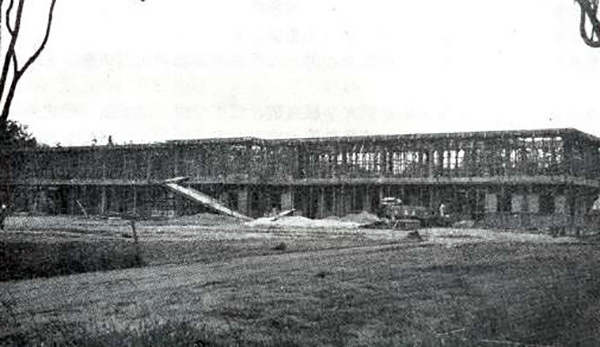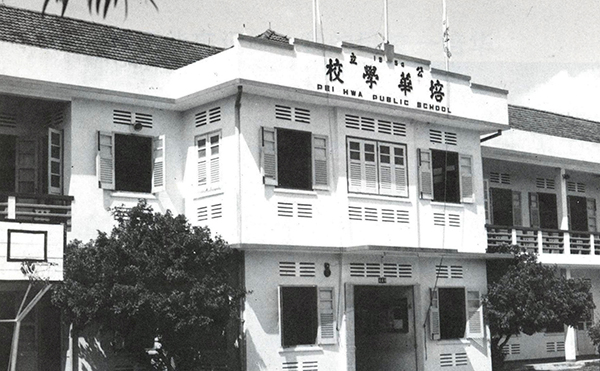

Our History

1934
When it was first established in the second half of 1934 by Mr. Ang Kong Peng(洪恭品先生) at 10 m.s. Yio Chu Kang Rd, it was known as Hwa Keow School. There were about ten pupils studying in a classroom behind then Bao An Tonic shop. A year later, there were more than twenty pupils. Classes were conducted inside the shop nearby due to small classroom size.
1935

In 1935, the elders in the village led by Mr. Ong Ker Kee(王可钳先生), Mr. Ang Kong Peng, Mr. Ang Lin Lee, Mr. Toh Yong Eik, Mr. Tan Teng Kar, together with the support by the shop owners of Chop Swee Huat Heng, Chop Sing Swee Huat and Chop Eik Huat, started to raise funds for the construction of a proper school building. Few months later, two classrooms, an office and two dormitories were erected at the opposite of the school premises.
1936

In 1936, Mr. Ong Ker Kee became the first Chairman of the School Management Committee and Mr. Chia Ti Sa was appointed as Principal. The school was registered as Pei Hwa Public School. A new teacher was employed to teach more than sixty pupils then.
1938
In 1938, Mr. Wang Long Xi(王龙溪先生)was elected Chairman. As recommended by Mr. Hou Xi Fan, Mr. Tay Beng Sin was appointed Principal. Classrooms were maintained and school affairs better managed. In 1939, Mr. Ong Ker Kee was re-elected Chairman. Learning atmosphere was improved and there were more than one hundred pupils. After raising funds, four more classrooms, a library and a hall were built. Dormitories for teachers were expanded too. First-batch pupils at higher level graduated and the school was then at the first stage of development. Mr. Hou Xi Fan went to villages personally to encourage the villagers to send their children to the school. In order to cater to the needs and convenience of the villagers, a branch was set up in the village and it housed the lower primary classes for more than thirty pupils.Mr. Xie Jia Tin managed the adminstration of the branch and major part of funds was raised by villagers led by Mr. Huang Yi Huan for covering the operating expenses of the branch.
1941
In 1941, Mr. Toh Kim Soo (卓金树先生) was elected chairman and he led a fund raising campaign for setting up a management fund for long-term operation of the school. Unfortunately, the development of both the main and branch schools was interrupted by the Japanese invasion. All furniture was destroyed and the branch school was pulled down. The school ceased classes for four years.
1945
After the Japanese occupation, Mr. Toh Kim Soo continued his chairmanship and the School Management Committee resolved the appointment of Mr. Lee Beng Chong as new principal. The school was re-opened on 8th October 1945 with about two hundred pupils. It took two years to repair the damages caused during the Japanese occupation. In 1947, a fun fair and an exhibition of arts and works were held.
1948

Mr. Ang Keong Lan was elected chairman for the term from 1948 to 1949 and he put forth his effort towards the development of the school. Mr. Toh Kim Soo was then re-elected chairman from 1950 to 1955. The pupil population began to increase and soon the School Management found that the facilities were insufficient to meet the demands of the education system. The School Management Committee formed a School Construction Sub-committee led by Mr. Toh Kim Soo, Mr. Ang Keong Lan (vice chairman then) and Mr. Wang Jin Yuan. The School Management Committee looked for an alternative site to build new school buildings and began a donation drive and fund raising. Other board members, 梁后宙、林建达、李金塔、胡绪哇、洪恩惠and 许乃炎先生assisted in raising funds from enterprises and general public and collectively a total sum of more than seventy thousand was raised. A piece of land (the present site) of about five acres was sought via 胡绪哇and it was only after long negotiation with the owner, Hock Ann Company, that he agreed to sell it to Pei Hwa School Management Committee.
1954

Building construction began in June 1954 and completed in December, costing $130,000. It comprised a two-storey building with twelve classrooms, an office, a library, a store room, a visitor’s lounge, a bookshop and a canteen. It could accommodate about one thousand pupils. It was one of the largest and well-equipped government aided schools then. According to donation of $5,000 from Mr. Toh Kim Soo, a room at the centre on 2nd storey was named as 卓克铎library and other classrooms were named in accordance with the donors, 洪恭兰、洪恩惠、王松美、李康塔、王振墙、王春斌、朱福水 who donated $2,000 each.
1955
In 1955, a scheme of government grants covering teachers’ remuneration was implemented but responses from Chinese medium schools at first were not encouraging. Chairman Mr. Ang Keong Lan felt that teachers’ remuneration was not adequate and school depending on tuition fee could not raise their remuneration. Board members stood by his stance that teachers’ remuneration should be raised and that the school would have less financial burden after accepting government aid. Mr Ang was nominated to apply for grants from Ministry of Education. Teachers’ remuneration was raised after his effort and schools nearby followed suit. The school became a government-aided Chinese school.
1956

From 1956, Mr. Ang Keong Lan served as the board chairman for 34 years continuously, the longest service to the school as Chairman. He started the phase II of the school development project which included a school hall, two dormitories and a big field. The whole project cost $120,000 and the sum was mainly borne by the School Management Committee and partly covered by funds raised from general public. The school in December 1961 held the 27th Anniversary cum the Inauguration of the School Assembly Hall. It held celebrating cultural performances in night and the Hokkien drama troupe新赛凤闽剧团sponsored in kind for two nights. The school management was proud of the drama troupe’s philanthropy.
1971

Management board resolved to name the conference room on 2nd storey of the hall as “Keong Lan Room 恭兰室” to express his contribution and donations towards the completion of the school’s expansion, including the hall. Pupils’ excellent academic results and performances in sports had raised the popularity of the school in Yio Chu Kang/Jalan Kayu areas and these were made possible under the leadership of Principal Mr. Lee Beng Chong. However, Principal Mr. Lee found that its facilities were inadequate to meet the needs of the community. Plans were then drafted for Phase III development including building special classrooms and improving sanitary equipment. At the end of 1971, he retired as Principal but was appointed adviser to School Management Committee, continuing to oversee the development of the school.
1972
In 1972, Mr.Tan Kheng Khuan became the new principal. Phase III development started in the same year. The school and management committee managed to raise more than $400,000 including $50,000 each from Mr. Ang Keong Lan’s company and Lee Foundation and a part from businesses and general public. Added with $210,000, grants from Ministry of Education, total sum raised was more than $600,000. The completed project in 1974 included a new block comprising six special rooms with modern sanitation. In the following year, with the full financial support of the management committee, another six classrooms and a retaining wall round the whole school compound were built.
1976
In 1976, principal Mr. Tan Kheng Khuan was assigned to the other school and Mr. Goh Gong Gong, senior assistant took over the post. He continued to complete expansion and upgrading project including library, language laboratory, science room and music room. Hence, the school was a well- equipped Chinese school in Yio Chu Kang area. In 1978, it started to register pupils for English stream and in the following year, pre-primary education was introduced. The school reached its peak by having 34 classes and was one of 28 primary schools receiving prioritised attention from the Ministry. In mid 1980s, with resettlement policy of the government, the residents in the area began to reside in HDB estates and the pupil population eventually began to decline.
1985

In Nov 1985, Mr. Goh Gong Gong retired but appointed as adviser to School Management Committee. Mr. Tay Liang Choong was posted from the other primary school to lead the school. He tried to uphold the morale and spirit of the school by upgrading the school facilities and improve the programs in the school. The library was renovated and air-conditioned, more books in English were added to boost the pupils’ standard in English. Many projects in English Language were implemented. Outdoor activities and games were encouraged and the school also participated in competitions. The school was able to win several district championships and a few national championships in badminton, table tennis and mini basketball.
1987
With small enrolment, the school was able to function only in the morning ever since 1987, leaving the afternoon free for the pupils to attend game practices and the teachers to give remedial lessons to the pupils who were weak in subjects. The PSLE results were constantly improving and better performance was expected at the end of each year.
1990
Government redevelopment began in late 1980s. Residents under resettlement plan gradually moved to new HDB housing estates like Ang Mo Kio, Hougang and Yishun. In retrospect of the last 55 years (1934 – 1989), the school was blessed with the financial and spiritual support from management committee, leadership of principals, contributions from teachers and administrative staff and all kinds of support given by businesses, general public and parents, and thus was able to fulfill its role in history.
In 1990, the school decided not to enroll pupils. Pupils and teachers thereafter were transferred to other schools by the Ministry of Education. School management committee resolved to retain the piece of land and all buildings situated. Pei Hwa Foundation Limited was then registered and school management committee dissolved. The Foundation has since been managing the land and the buildings within the premises.
Note: The above-mentioned is a brief description of the school’s history. Any error or omission is regretted.
